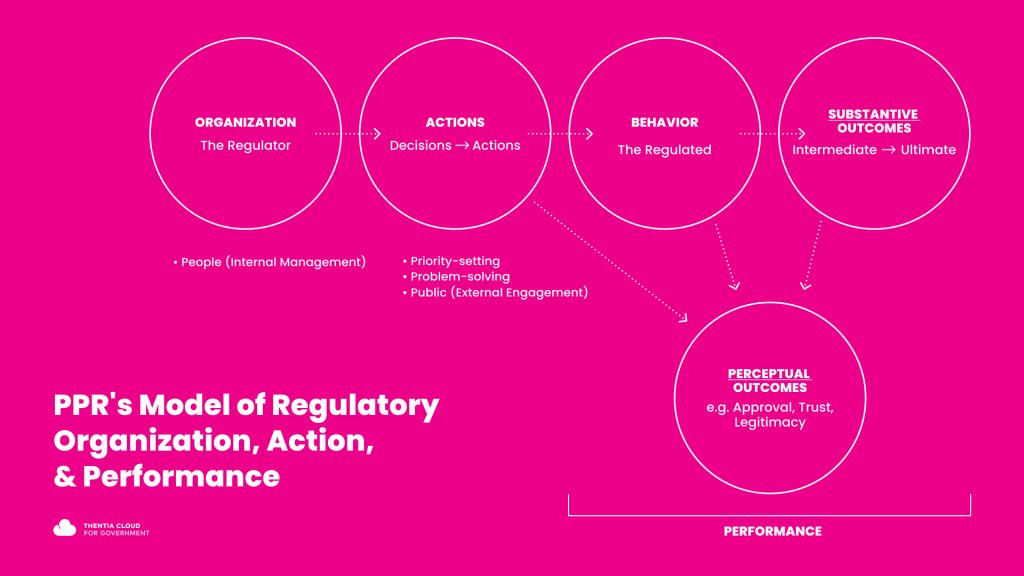In recent years, a commitment to regulatory excellence has become a commonly found priority embedded in the mission or vision statements of regulators. But what exactly defines regulatory excellence? And how can regulators achieve it?
In 2014, the newly created Alberta Energy Regulator (AER) was one of many regulators grappling with these questions. They wanted to identify the key attributes of an excellent regulator, understand how they could adopt those attributes, and define how they could measure progress. To accomplish this, they enlisted the help of experts from the world-renowned Penn Program on Regulation (PPR) at the University of Pennsylvania to lead an independent project that would define, measure, and verify the attributes of a leading regulator known as the Best-in-Class Regulator Initiative.
The project culminated in a final report, written by PPR Director Cary Coglianese, titled Listening, Learning, and Leading: A Framework for Regulatory Excellence (2015), which provided a general model of regulatory excellence that could be adapted by regulators across sectors to reflect their unique work and challenges. Here, we’ll review the key findings of the report, which can help regulators as they chart their own paths to achieve regulatory excellence.
The three core attributes of regulatory excellence
Coglianese noted that the PPR team encountered literally hundreds of adjectives that could be used to describe excellent regulators throughout the course of their research, including transparent, fair, consistent, flexible, accountable, adaptive, trustworthy, effective, credible, equitable, and efficient. However, the report distills the essence of all these adjectives into three core attributes of excellence:
1. Utmost integrity: this refers to a regulator’s commitment to serving the public interest, respecting the law, and working with elected legislators.
2. Empathic engagement: in addition to transparency and public engagement, this attribute is also about how respectfully the regulator treats regulated entities and other stakeholders.
3. Stellar competence: this refers to the actual delivery of outcomes that maximize public value and the actions taken to achieve a high level of performance.
The nine tenets of regulatory excellence
Building off these three core attributes, researchers identified nine core tenets of regulatory excellence that Coglianese described as “the most significant, comprehensive but still compact aspirational statements of regulatory excellence of any that we have encountered.” The nine tenets are:
An excellent regulator consistently holds itself to the highest standards of integrity.
1. Fidelity to law: an excellent regulator complies with all legitimate laws.
2. Respect for democracy: an excellent regulator follows the directions of elected representatives and initiates/contributes to public dialogue on issues relevant to its mission.
3. Commitment to public interest: an excellent regulator serves the public first and foremost.
An excellent regulator engages empathically with all segments of society when making decisions and exercising authority.
4. Even-handedness: an excellent regulator engages fairly with all affected interests.
5. Listening: an excellent regulator listens to the perspectives of all those with interests at stake in its decisions.
6. Responsiveness: an excellent regulator responds to concerns and fully and transparently explains its decisions.
An excellent regulator demonstrates consistently stellar competence by using its available resources to maximize public value.
7. Analytical capability: an excellent regulator seeks out reliable data, uses the best available evidence to conduct analysis of its actions and decisions, and seeks to reduce and manage risks intelligently.
8. Instrumental capacity: an excellent regulator uses the best tools and technologies available to solve problems and seeks continuous improvement through regular performance measurement and evaluation.
9. High performance: an excellent regulator consistently delivers significant positive public value.
Coglianese emphasizes that to be excellent, a regulator must meet all of these tenets, not just some, writing that “A regulator that is not aligned well with all nine tenets might be a good regulator; it could not be said to be an excellent regulator.”
How can a regulator achieve or maintain excellence?
According to the PPR team, to be truly excellent, regulators must exhibit utmost integrity, empathic engagement, and stellar competence in three areas: the traits of their organizations (i.e., organizational culture); their regulatory-related actions; and in the outcomes of their actions (e.g., if their actions have publicly valued outcomes such as reducing risks and/or increasing efficiencies).
Although Coglianese acknowledges that there is no simple formula for achieving regulatory excellence that applies to all regulators in all cases, the PPR team offers a general model – visualized as the causal “chain” illustrated below – that any regulator can find useful.

To become (or remain) excellent, regulators must ensure that this “chain” operates in a way that aligns with the core attributes and tenets of regulatory excellence. A regulator’s performance is measured by outcomes in terms of behavioral changes, perceptual outcomes, and substantive outcomes. Within the first two steps on the chain are four key facets of a regulator’s organization and actions that will affect its ultimate performance: internal management; external engagement; priority-setting/decision-making; and problem-solving.
The researchers offer the following guidance on how a regulator should approach each of these key facets of its operations to achieve regulatory excellence:
1. Internal management: maintaining mission clarity, ensuring adequate resources, building strong human capital, and maintaining appropriate autonomy should be prioritized.
2. Priority-setting/Decision-making: an excellent regulator should set priorities informed by the proper consideration of risks and employ evidence-based decision-making.
3. Problem-solving: a flexible approach to regulatory problem-solving is preferred, as it allows regulators to choose the most cost-effective way to achieve the desired outcomes.
4. External engagement: seeking public engagement earlier and more often is recommended. Engagement should be empathic and focused on listening, and the public should be given explanations for regulatory decisions.
Coglianese notes that developing “people excellence” is crucial for regulators to improve these four facets and perfect the chain of regulatory excellence, which means ensuring that the people working at their organizations embody all three attributes of excellence. “Only if the people working in a regulatory authority are committed to doing their utmost to deliver public value, and to learning and improving their ability to deliver that value in a manner that demonstrates respectful engagement with others, can a regulator expect to achieve true excellence,” he writes.
Up next: putting it all together and measuring progress
Now that we have a solid understanding of what makes an excellent regulator and the general model of how regulators can achieve excellence, in Part 2 of this series we’ll review the PPR team’s strategic recommendations for regulators seeking excellence and how they can measure their progress.








